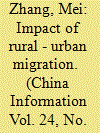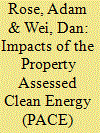|
|
|
Sort Order |
|
|
|
Items / Page
|
|
|
|
|
|
|
| Srl | Item |
| 1 |
ID:
130539


|
|
|
|
|
| Publication |
2014.
|
| Summary/Abstract |
This paper measures the economic impacts of climate change on China's grain production by using provincial time series data over a 32-year period. The panel data model and time series region model with/without adaptation are applied at the same time to assess the effectiveness of a common production function. To capture the effects of weather variables we employ a random coefficients model where the production elasticities are the logarithmic function on temperature and rainfall. A Cobb-Douglas production function with additional interaction between inputs and climate variables is applied. We find that the economic impacts of climate change are mixed, that is, some regions are winners and others are losers, and the effect is crop-specific, not general. With adaptation, the economic impacts of warming on grain production are always positive; less precipitation will benefit rice production, but will harm wheat and maize production. Most of the central, western and northern China, which have already been adapted, are less sensitive to climate variables, but some eastern provinces, such as Shandong and Hebei, are very vulnerable. However, this study finds that the adaptation by irrigation is not sensitive to climate change. In summary, the analysis indicates that policymakers should recognize that the climate change would change the productivity of factors, so a regional and crop-specific total-factor-adaptation model is recommended.
|
|
|
|
|
|
|
|
|
|
|
|
|
|
|
|
| 2 |
ID:
098334


|
|
|
|
|
| Publication |
2010.
|
| Summary/Abstract |
As a result of China's marketization in recent years there has been an enormous number of rural-urban migrants. Based on a case study in poor villages on the Loess Plateau of central China, and referring to the overall framework of migration theories, this article examines the social and economic characteristics of migrants and their households, and discusses to what extent rural- urban migration contributes to the social and economic development of the migrant-sending areas, especially in reducing poverty
|
|
|
|
|
|
|
|
|
|
|
|
|
|
|
|
| 3 |
ID:
171406


|
|
|
|
|
| Summary/Abstract |
The Property Assessed Clean Energy (PACE) Program is an innovative financing approach to meeting environmental goals. PACE financing is structured as an assessment to the property and paid along with the property tax bill. In addition to the direct environmental benefits, it also yields co-benefits of enhanced economic output and employment. This paper estimates the economic impacts of PACE in California by one of its major financing companies. These impacts include direct spending on structural improvements, reduction in spending on centralized power and water services, reallocation of spending from energy and water bills savings, and solar investment tax credits, among others. It also includes general equilibrium effects of these various factors. Our results indicate PACE financing yields sizable economic benefits. At the same time, the increased economic activity results in increased energy and water use that partially offsets some of the direct environmental gains. Furthermore, PACE has been subject to criticism because it gives financing companies the first lien on mortgages and because of anecdotal examples of some customers being lured by unscrupulous contractors. The direct environmental benefits and economic co-benefits of PACE should be factored into the policy debate over whether the Program should be further expanded or regulated.
|
|
|
|
|
|
|
|
|
|
|
|
|
|
|
|
| 4 |
ID:
147066


|
|
|
|
|
| Summary/Abstract |
During the last decades, the activities of pirates have increased exponentially in Eastern Africa, with their attacks becoming considerably more violent. In addition to the intrastate and interstate conflicts, the lack of state capacity and the presence of terrorist groups, maritime piracy represents a serious and sustained threat to economic security. Indeed, from an economic point of view, pirates affect international trade through an increasing insecurity related to the prompt delivery of the goods transported. The aim of this work is to explore the main works on maritime piracy analyzed in quantitative economics.
|
|
|
|
|
|
|
|
|
|
|
|
|
|
|
|
| 5 |
ID:
193747


|
|
|
|
|
| Summary/Abstract |
Decarbonizing road transport – through electrification, public transport, and walking and biking – can be a net social benefit thanks to reduced congestion, accidents, air pollution, and energy costs. However, governments face losing fuel and vehicle tax revenue. We develop for the first time a method to assess options to maintain fiscal revenues without hampering decarbonization benefits for firms and households. We estimate the financial impact of transport decarbonization on the government, firms (buses, taxis, freight, and other private uses), and households grouped by income level and region of residence. Then, we evaluate how the government can use energy, property, import, and distance-based tax adjustments to compensate for the fiscal cost of decarbonization, and the incidence of these adjustments on firms and households. We apply the method to Costa Rica, a country committed to reaching net-zero emissions by 2050 and where 20% of government revenue comes from transport taxes. Decarbonizing transport would cause a fiscal impact of −0.41% of GDP on average between 2023–50, which is lower than the financial benefits on households and firms: +1.49% of GDP. We show that a combination of tax adjustments would eliminate the fiscal impact while maintaining net benefits for all firms and households of all income levels and regions of residence.
|
|
|
|
|
|
|
|
|
|
|
|
|
|
|
|
| 6 |
ID:
191270


|
|
|
|
|
| Summary/Abstract |
We examine the impact of large-scale photovoltaic projects (LSPVPs) on residential home prices in six U.S. states that account for over 50% of the installed MW capacity of large-scale solar in the U.S. Our analysis of over 1,500 LSPVPs and over 1.8 million home transactions answers two questions: (1) what effect do LSPVPs have on home prices and (2) does the effect of LSPVP on home prices differ based on the prior land use on which LSPVPs are located, LSPVP size, or a home's urbanicity? We find that homes within 0.5 mi of a LSPVP experience an average home price reduction of 1.5% compared to homes 2–4 mi away; statistically significant effects are not measurable over 1 mi from a LSPVP. These effects are only measurable in certain states, for LSPVPs constructed on agricultural land, for larger LSPVPs, and for rural homes. Our results have two implications for policymakers: (1) measures that ameliorate possible negative impacts of LSPVP development, including compensation for neighbors, vegetative shading, and land use co-location are relevant especially to rural, large, or agricultural LSPVPs, and (2) place- and project-specific assessments of LSPVP development and policy practices are needed to understand the heterogeneous impacts of LSPVPs.
|
|
|
|
|
|
|
|
|
|
|
|
|
|
|
|
| 7 |
ID:
189455


|
|
|
|
|
| Summary/Abstract |
The legacy of the 1999 Columbine School shooting has resulted in increased political elements in subsequent shootings and the line between these school shooters and terrorists has blurred. Current research comparing terrorists and school shooters has largely focused on the similarities between the perpetrators using largely qualitative methods. With the behavioural and subsequent economic impacts of terrorism having been previously identified, this paper investigates if these behavioural changes and impacts are present following school shootings. Through the use of a logit regression of historical school shooting data, we find evidence that support our theories that school shootings cause fear and change consumer behaviours.
|
|
|
|
|
|
|
|
|
|
|
|
|
|
|
|
| 8 |
ID:
110733


|
|
|
|
|
| Publication |
2011.
|
| Summary/Abstract |
This paper uses the Jobs and Economic Development Impacts (JEDI) model to estimate economic impacts from 1398 MW of wind power development in four counties in west Texas. Project-specific impacts are estimated at the local level (i.e., within a 100-mile radius around the wind farms) and at the state level. The primary economic policy question addressed is how investment in wind energy affects the state and local communities where the wind farms are built. During the four-year construction phase approximately 4100 FTE (full time equivalents) jobs were supported with turbine and supply chain impacts accounting for 58% of all jobs generated. Total lifetime economic activity to the state from the projects equated to more than $1.8 billion, or $1.3 million per MW of installed capacity. The total economic activity to the local communities was also substantial, equating to nearly $730 million over the assumed 20-year life cycle of the farms, or $0.52 million per MW of installed capacity. Given the current level of impacts observed, and the potential for increased impacts via greater utilization of instate manufacturing capacity and the development of trained wind industry specific laborers, Texas appears to be well positioned to see increasing impacts from continued wind development.
|
|
|
|
|
|
|
|
|
|
|
|
|
|
|
|
|
|
|
|
|